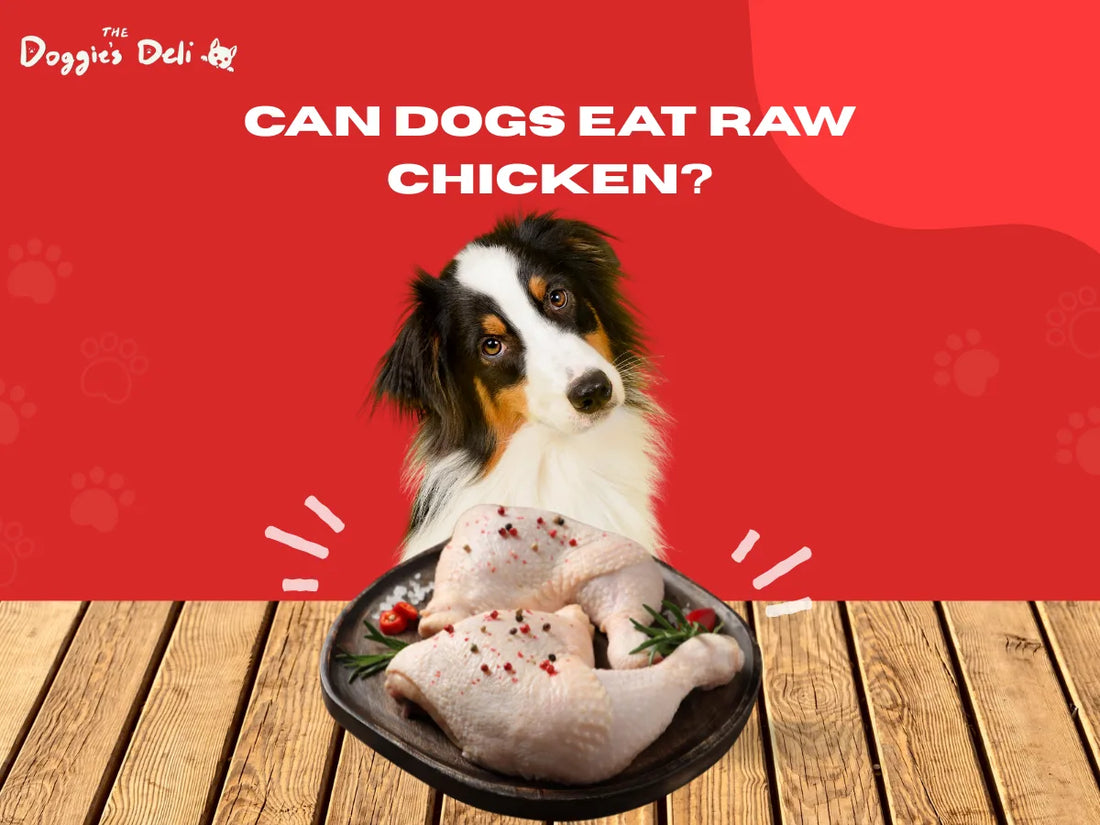
Can Dogs Eat Raw Chicken?
Share
Yes, dogs can eat raw chicken, but it’s important to carefully consider the risks and benefits. Raw chicken is a great source of high-quality protein, essential amino acids, and healthy fats, which can support muscle development, a shiny coat, and overall health. However, feeding raw chicken can also pose risks, such as bacterial infections from Salmonella and E. coli, which can affect both dogs and humans. Additionally, raw chicken bones may present choking hazards or cause internal injuries.
Before feeding raw chicken to your dog, it’s crucial to consult a veterinarian to ensure it’s a safe and suitable option for their diet. A vet can help assess your dog’s health and dietary needs, recommend proper portion sizes, and guide you on how to handle and store raw chicken safely. This step will help reduce potential health risks and ensure that the raw feeding approach is balanced and appropriate for your dog’s specific requirements.
Nutritional Benefits of Raw Chicken for Dogs
Raw chicken is rich in high-quality protein, supporting muscle growth and tissue repair. It also contains omega-3 and omega-6 fatty acids, promoting coat health and reducing inflammation. Additionally, raw chicken provides essential vitamins and minerals, like B-vitamins, phosphorus, and selenium, which support energy production, immune function, and bone health. For optimal nutrition, raw chicken should be fed in moderation as part of a balanced diet to prevent nutritional imbalances.
The benefits of feeding raw chicken to your dog:
1. High-Quality Protein
Scoring 79 out of 100, raw chicken is a highly beneficial source of protein for dogs. Protein is vital for muscle development, tissue repair, and overall health. The amino acids in raw chicken are essential for maintaining muscle mass and supporting immune function, while also helping repair cells. Active or growing dogs particularly benefit from adequate protein intake, as it provides the energy they need. While raw chicken is an excellent protein source, it should be complemented with other nutrients to ensure a balanced and healthy diet for your dog.
2. Omega-3 and Omega-6 in Raw Chicken
Raw chicken provides an important source of both omega-3 and omega-6 fatty acids, which are essential for your dog's health. Omega-3s help reduce inflammation, promote joint health, and support brain function, making them particularly beneficial for senior or active dogs. Omega-6 fatty acids, on the other hand, are key for maintaining healthy skin, a shiny coat, and proper heart function.
To achieve the best health benefits, it’s important to maintain a balanced ratio of omega-3 to omega-6. Too much omega-6 can increase inflammation, while a lack of omega-3 can limit its anti-inflammatory effects. Including raw chicken as part of your dog's diet ensures they receive these essential fatty acids in the right balance for overall well-being.
3. Packed with Vitamins and Minerals in Raw Chicken
Essential vitamins and minerals, such as B-vitamins, selenium, and phosphorus, play a significant role in supporting your dog’s health. B-vitamins help with energy production and maintain a healthy nervous system, while selenium acts as an antioxidant that boosts the immune system. Phosphorus is crucial for strong bones and teeth, working alongside calcium for optimal skeletal health.
These nutrients are vital for various bodily functions. B-vitamins ensure sustained energy, selenium enhances immune response, and phosphorus strengthens bones. Incorporating these key vitamins and minerals into your dog’s balanced diet helps promote long-term health and well-being.
4. Organ Meat Benefits
Liver, feet, and gizzards are nutrient-packed parts of raw chicken that offer exceptional health benefits for dogs. These organ meats are rich in high-quality protein, vitamins, and minerals. Liver is especially beneficial, providing essential nutrients like vitamin A, B-vitamins, and iron, which support eye health, energy levels, and red blood cell production. Chicken feet and gizzards are also excellent sources of protein and collagen, which help improve joint health and maintain healthy skin.
Including these nutrient-dense organ meats in a balanced raw diet ensures your dog gets a concentrated boost of essential nutrients, supporting their immune system, energy, and joint health for optimal long-term well-being.
Risks and Concerns of Feeding Raw Chicken to Dogs
Feeding raw chicken to dogs comes with several potential risks. Bacterial infections from Salmonella, E. coli, and Campylobacter can pose serious health threats. Additionally, raw chicken bones present choking hazards and may cause internal injuries. Raw diets may also lead to nutritional imbalances if not properly balanced. To minimize these risks, it's essential to handle raw chicken safely and consult a veterinarian before introducing it to your dog’s diet.
1. Bacterial Infections from Salmonella, E. coli and Campylobacter
When handling raw meat, dogs are at risk of contracting harmful bacteria like Salmonella, E. coli, and Campylobacter. These pathogens can lead to serious health issues such as vomiting, diarrhea, fever, and fatigue. In some cases, the infection may become severe, causing dehydration and requiring immediate veterinary treatment.
To reduce the risk, it’s essential to follow proper food safety protocols. This includes washing your hands, utensils, and surfaces after handling raw meat, as well as ensuring proper storage and thawing practices. Safe handling is crucial to avoid cross-contamination and bacterial growth. Before adding raw chicken to your dog’s diet, it’s recommended to consult with a veterinarian to ensure safe feeding practices.
2. Choking Hazard: Comparing Raw vs Cooked Bones
Feeding raw chicken to dogs increases the risk of bacterial infections from harmful pathogens like Salmonella, E. coli, and Campylobacter. These bacteria can cause severe gastrointestinal symptoms, including vomiting, diarrhea, and fever. In more severe cases, they can lead to dehydration, internal infections, and even long-term health complications.
Salmonella and Campylobacter are particularly concerning because they can also spread to humans, causing similar symptoms in people who handle contaminated food or surfaces. To prevent infection, it’s vital to handle raw chicken carefully, wash hands and utensils thoroughly, and store the meat at safe temperatures. Consulting a veterinarian before feeding raw chicken to your dog ensures you understand the necessary precautions and reduces the risk of harmful bacterial exposure.
3. Nutritional Imbalance in a Raw Diet
A raw diet, if not properly balanced, can lead to nutritional deficiencies that impact a dog's overall health. While raw chicken provides valuable protein and healthy fats, it may not offer all the essential nutrients required for a dog’s optimal health, such as calcium, vitamin E, and specific amino acids. A lack of these nutrients can result in bone weakness, immune system issues, and even skin problems.
For example, a diet that relies too heavily on raw meat may lack sufficient calcium, which is vital for strong bones and teeth. To prevent nutritional imbalances, it’s crucial to complement raw chicken with other protein sources, organ meats, and appropriate supplements. Consulting with a veterinarian or pet nutritionist ensures that the diet is well-rounded, safe, and provides the correct proportions of all necessary nutrients for long-term health.
Practical Guidance for Feeding Raw Chicken to Dogs
When feeding raw chicken to dogs, it's essential to follow practical steps for safety and balance. Start by sourcing high-quality, human-grade chicken to minimize contamination risks. Proper handling, including safe storage, thawing, and hygiene practices, is key to preventing bacterial infections. Portion control based on your dog's size and activity level ensures they get the right amount of nutrition. Finally, a balanced diet with other proteins and organ meats is crucial for health, so always consult a veterinarian before starting a raw feeding regimen.
1. Choosing Safe, Human-Grade Chicken for Your Dog
Selecting human-grade chicken is essential when feeding raw to ensure the highest level of safety and quality for your dog. Human-grade chicken undergoes stricter inspections and quality control, reducing the risk of harmful contaminants that can be present in lower-quality meat, such as bacteria or antibiotics.
By choosing human-grade chicken, you ensure that the meat is free from dangerous additives and is handled in a way that minimizes contamination risks. Always opt for reputable sources that provide high-quality, raw chicken specifically intended for pet consumption. This ensures that your dog receives the safest and healthiest food possible
2. Proper Handling for Storage, Thawing and Hygiene
When feeding your dog raw chicken, proper handling is essential to prevent foodborne illness. Always store raw chicken in the refrigerator at temperatures below 40°F (4°C) or freeze it at 0°F (-18°C) to slow bacterial growth. Ensure the chicken is kept in an airtight, leak-proof container to prevent contamination from other foods.
Thaw chicken slowly in the refrigerator, never on the countertop or in warm water, as this can encourage bacterial growth. After handling raw meat, wash your hands, utensils, and surfaces thoroughly with hot, soapy water to avoid spreading harmful bacteria. These practices are crucial for ensuring your dog’s health and minimizing the risk of contamination.
3. Balanced Diet with Other Proteins and Organ Meat
Incorporating a variety of proteins and organ meats into your dog’s raw diet is essential for maintaining optimal health. While raw chicken offers valuable protein, it may not provide all the necessary nutrients for your dog’s overall well-being. By including other proteins like beef, fish, pork or lamb, you can ensure a broader nutrient profile, including different amino acids and essential fatty acids.
Organ meats such as liver, kidneys, and heart are also crucial for a balanced diet. These meats are rich in vitamins like A and B12, along with minerals like iron and zinc, which support immune health, energy production, and bone strength. A variety of protein sources, combined with organ meats, ensures your dog receives the full range of nutrients needed for long-term health.
4. Adjusting Portions for Size and Activity
Portion control is a crucial aspect of feeding raw chicken to ensure your dog receives the right amount of nutrition. The portion size should vary depending on the dog’s size, breed, and activity level. Larger or more active dogs require more food to maintain energy levels, while smaller or less active dogs need smaller portions to prevent overfeeding.
For example, an active, large breed dog will need a higher caloric intake compared to a smaller, sedentary dog. Accurately measuring portions is essential to avoid the risks of overfeeding, which can lead to obesity, or underfeeding, which may result in nutritional deficiencies. Using a scale to weigh food and consulting with your vet will help ensure your dog is getting the right amount for optimal health.
How to Feed Raw Chicken to Dogs Safely and Effectively
Feeding raw chicken to dogs requires careful planning and safety precautions. Start by sourcing high-quality, human-grade chicken and handle it properly to prevent contamination. Portion sizes should be adjusted based on your dog’s size and activity level, while balancing the diet with other proteins and organ meats. Consult a veterinarian for expert advice to ensure your dog’s diet is safe, complete, and nutritionally balanced, reducing the risk of health issues.
A proper step by step guide to feed your dog raw chicken:
Step 1: Properly Thawing Raw Chicken
Before feeding raw chicken to your dog, it’s crucial to thaw it properly to avoid potential bacterial contamination. The safest method is to place the chicken in the refrigerator to defrost slowly, keeping the temperature at or below 40°F (4°C). This allows the chicken to thaw evenly without encouraging bacterial growth. Never leave raw chicken out at room temperature, as bacteria can multiply rapidly in warmer conditions. Additionally, avoid using hot water or microwaving the chicken, as these methods can lead to uneven thawing and increase the risk of foodborne illness. Proper thawing ensures a safe, healthy meal for your dog.
Step 2: Handling Raw Chicken Safely
Raw chicken requires strict handling procedures to avoid contamination and ensure the safety of both your dog and your household. Always start by washing your hands with hot, soapy water before and after touching raw chicken. Use separate utensils, cutting boards, and knives specifically for raw meat to prevent cross-contamination. After preparing the chicken, disinfect the surfaces and utensils thoroughly to remove any bacteria like Salmonella or E. coli.
Additionally, never leave raw chicken exposed to air for long periods, as bacteria can multiply rapidly. If you’re storing leftover raw chicken, place it in a sealed container and refrigerate immediately to slow bacterial growth. By following these handling practices, you minimize contamination risks and ensure your dog’s raw food is safe for consumption.
Step 3: Correct Portion Control for Dogs
Feeding raw chicken in the right portions is crucial for your dog’s health and well-being. The amount of food should be adjusted based on your dog’s size, activity level, and overall health. Typically, dogs should consume about 2-3% of their body weight in raw food daily, but active or working dogs may need more, while less active dogs may need less.
Portion control helps prevent overfeeding, which can lead to weight gain, and underfeeding, which can cause nutrient deficiencies. It’s important to use a kitchen scale to measure portions accurately and regularly adjust the amount based on your dog’s weight and condition. Consulting with a veterinarian will ensure the portions are appropriate and your dog’s nutritional needs are met.
Step 4: Introducing Raw Chicken to Your Dog
Gradually introducing raw chicken into your dog’s diet is key to preventing digestive upset. Start by replacing 10-20% of their regular food with raw chicken, and gradually increase the portion over the course of several days. This allows their digestive system time to adjust.
While making the transition, monitor your dog for any signs of digestive discomfort, such as diarrhea, vomiting, or changes in stool consistency. If adverse reactions occur, stop feeding raw chicken and consult with your veterinarian. A slow introduction will help minimize health risks and ensure your dog adapts to the new diet safely.
Can I Feed My Dog Raw Chicken Every Day?
Feeding raw chicken every day can be risky for dogs, as it may lead to nutritional imbalances. While raw chicken provides essential protein, it lacks certain vital nutrients such as calcium, vitamin E, and other minerals necessary for bone health, immune function, and overall vitality. Regularly feeding only raw chicken can result in deficiencies that impact your dog’s long-term health.
To maintain balance, it’s crucial to offer a variety of protein sources, including beef, turkey, or fish, and include organ meats like liver and kidneys for added vitamins and minerals. Moderation and diversity in your dog’s diet are essential, and consulting a veterinarian will help ensure that your dog is receiving a complete, safe, and well-rounded nutrition plan.
What Should I Do If My Dog Eats Raw Chicken?
If your dog eats raw chicken accidentally, monitor for signs of illness, such as vomiting, diarrhea, or lethargy, as it may carry bacteria like Salmonella or E. coli. Additionally, raw bones could cause choking or internal injuries.
If symptoms appear, contact your veterinarian immediately for guidance. Prompt action is essential to ensure your dog’s health and safety. Your vet can provide the appropriate treatment and advice.
Alternatives to Raw Chicken
Some dog owners choose alternatives to raw chicken due to concerns about bacteria, allergies, or diet variety. High-quality dog treats and protein-packed snacks, such as freeze-dried meats or chews, are convenient and safe options that provide essential nutrients without the risks of raw meat.
Including these alternatives helps add variety and supports your dog’s health. Always choose treats from reputable sources, like The Doggies Deli, to ensure they are free from harmful additives. Sourcing high-quality treats ensures your dog’s diet remains nutritious and balanced.










